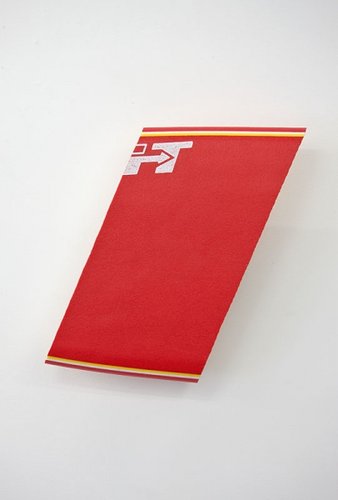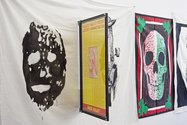John Hurrell – 27 April, 2010
If the show is exciting enough as a curated project and attracts attention, the artist guests get introduced to new audiences who perhaps buy work. The other artists appreciate the new contextualisation. They enjoy the support.
Auckland
Chris Lipomi
Interactive Visual History Compression (The Ks)
Featuring work by Kelley, Kippenberger, Kinney, Konitz, Kos, Krebber and Kuchar
21 April - 15 May 2010
Chris Lipomi is one of those artists interested in the merging of creative identity and blending of artistic content or style. We have here an exhibition that is a sort of voluntary cuckoo-host, where an artist has devised his own show to include several other artists whom he admires, generously inviting them to pop their eggs into his own (gallery) nest. Whilst it could be seen as a shrewd way of clinging to their shirt tails if they are superstars and advancing himself, if the show is exciting enough as a curated project and attracts attention, those guests get introduced to new audiences who perhaps buy work. The other artists appreciate the new contextualisation.They enjoy the support.
Lipomi’s installation at Michael Lett incorporates parallel railway sleepers as seats for looking at videos. It gives us the chance to investigate several artists (all with names beginning with K) mostly not seen here before, mixed in with some fake Kaprows, and Kawaras.There are lots of surprises.
For example, there is a wonderfully verbose, double-sided Mike Kelley poster, The Great Tragedy of the Bill Clinton Administration…(under glass but on a hinge), which attacks America’s fixation on celebrity culture and on sexual desire. As a remedy he recommends that all Hollywood stars be compelled to do medical work in clinics for sexual diseases. Kelley’s poster and a silkscreened, coloured cotton table cloth are blended into a row of imitation Lipomi ‘Kelleys’ in a mash up of artistic identities.
Other works make the presence of ‘authentic’ individuality much clearer. There is a Martin Kippenberger set of nine wooden frames converted with Mylar and black tape into a game of noughts and crosses. To perpetuate his hang dog ‘loser’ image, there is never a winner (i.e. a line of three) in its hanging arrangement.
There is also a riddlelike Paul Kos with a coathanger hanging off the top of a broom handle, balanced by a bell one end and a candle at the other. It seems to be a meditation about thought and action, the activity of sweeping seen as generating ideas - symbolised by the lighting of the candle or the ringing of the bell.
Cologne conceptual painter Michael Krebber once worked for Martin Kippenberger as his assistant, and Kippenberger often used his ideas. He displays here a black and white painting showing an excerpt of a smeared photocopied comic where sections of teenage action are densely overlaid with confusing text. The year later (2008) he showed at Maureen Paley in London, a similar series of images based on French cowboy comics.
Krebber also has a slice of a red windsurfing board on Michael Lett’s wall. The tilted, sawn off parallelogram seems to be a metaphor for the adventurous side of an art career, a journey over the waves where work is fun, a recreational, even escapist, activity. Another interpretation (on an online blog) is that it is created to mock ‘sculpture’s bodily immediacy’. That seems farfetched. The work embraces immediacy - even as a mutilated readymade.
Kieran Kinney contributes a dramatic, completed oil painting. Men Are Back is a send up of the film ‘Men In Black’ and seems an amusing photorealist comment on gender balance in the art sector, saying that the current apparent dominance by women is changing. Maybe that is accurate in Melbourne, the city where Kinney lives, or Australia.
Los Angeles artist Alice Könitz has two tightly geometric, formally elegant, cardboard masks that link to a nearby video where similarly masked actors balance on tree trunks and mumble lines from Genet, Brecht or other playwrights. The masks are great but the video is superfluous.
The videos of New York underground film-maker George Kuchar are less pretentious. He has two low budget, low tech, richly layered works about variable weather patterns and places he visits when travelling. They are structured around what seems to be Kuchar himself playing the bored out-of-towner, either cleaning filthy bathrooms in sleazy motels or gazing anxiously out of grubby windows - pondering the local wildlife or contemplating changing cloud formations. Apparently he used to earn a living painting weather maps for television studios.
This is one of those shows you need to look at in the space, go home and do some Googling or ferreting around with your stack of favourite art mags, and then return for another squiz - with some new contextual background under your belt. There is a lot here to ruminate over - particularly with Kelley, Kos, Krebber, Kuchar and Kinney. It’s an unusual, extremely interesting exhibition.
John Hurrell










 Two Rooms presents a program of residencies and projects
Two Rooms presents a program of residencies and projects Advertising in this column
Advertising in this column



This Discussion has 0 comments.
Comment
Participate
Register to Participate.
Sign in
Sign in to an existing account.